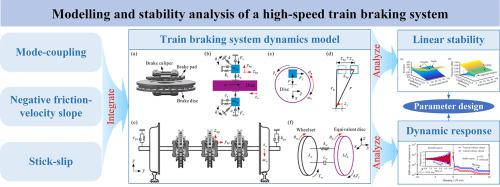International Journal of Mechanical Sciences ( IF 7.1 ) Pub Date : 2023-03-12 , DOI: 10.1016/j.ijmecsci.2023.108315 Quan Wang , Zhiwei Wang , Jiliang Mo , Zhongrong Zhou

|
The stability of a braking system is crucial for the steady and safe operation of trains. To investigate the dynamic behaviors and stability of a train braking system as influenced by key parameters, a numerical model integrating mode-coupling, negative friction–velocity slope (NFVS), and stick–slip theories was established. Additionally, the wheelset connected with the braking system was contained in the model considering that mode-coupling and stick–slip characteristics were affected by system structures. Based on this model, the influence and mechanism of stiffness, damping, and NFVS characteristics on mode-coupling of the braking system were revealed. The results showed that when the tangential and normal contact stiffness values of the pad were close, the system experienced mode-coupling instability and vibrations in these two directions were coupled. When the tangential and normal damping values of the pad were unequal, the energy dissipation in the two directions became different and the system instability was enhanced. Additionally, the system complex eigenvalues always had positive real parts and the dynamic behaviors were more complicated by considering NFVS at relatively low speeds. This is because NFVS characteristics can be equivalent to negative damping values, which cause the difference in tangential and normal damping values and continuously input energy into the braking system, then weakening the system stability.
中文翻译:

某高速列车制动系统建模与稳定性分析
制动系统的稳定性对于列车的平稳安全运行至关重要。为了研究受关键参数影响的列车制动系统的动态行为和稳定性,建立了一个集成模式耦合、负摩擦速度斜率 (NFVS) 和粘滑理论的数值模型。此外,考虑到模式耦合和粘滑特性受系统结构的影响,将与制动系统连接的轮对包含在模型中。基于该模型,揭示了刚度、阻尼和NFVS特性对制动系统模式耦合的影响和机理。结果表明,当垫块的切向和法向接触刚度值接近时,系统经历模式耦合不稳定,这两个方向的振动被耦合。当垫块的切向和法向阻尼值不相等时,两个方向的能量耗散变得不同,系统不稳定性增强。此外,系统复杂的特征值始终具有正实部,并且通过在相对较低的速度下考虑 NFVS,动态行为更加复杂。这是因为NFVS特性可以等效为负阻尼值,导致切向阻尼值与法向阻尼值存在差异,不断向制动系统输入能量,削弱系统的稳定性。两个方向的能量耗散变得不同,系统的不稳定性增强。此外,系统复杂的特征值始终具有正实部,并且通过在相对较低的速度下考虑 NFVS,动态行为更加复杂。这是因为NFVS特性可以等效为负阻尼值,造成切向阻尼值与法向阻尼值存在差异,不断向制动系统输入能量,削弱系统的稳定性。两个方向的能量耗散变得不同,系统的不稳定性增强。此外,系统复杂的特征值始终具有正实部,并且通过在相对较低的速度下考虑 NFVS,动态行为更加复杂。这是因为NFVS特性可以等效为负阻尼值,造成切向阻尼值与法向阻尼值存在差异,不断向制动系统输入能量,削弱系统的稳定性。











































 京公网安备 11010802027423号
京公网安备 11010802027423号